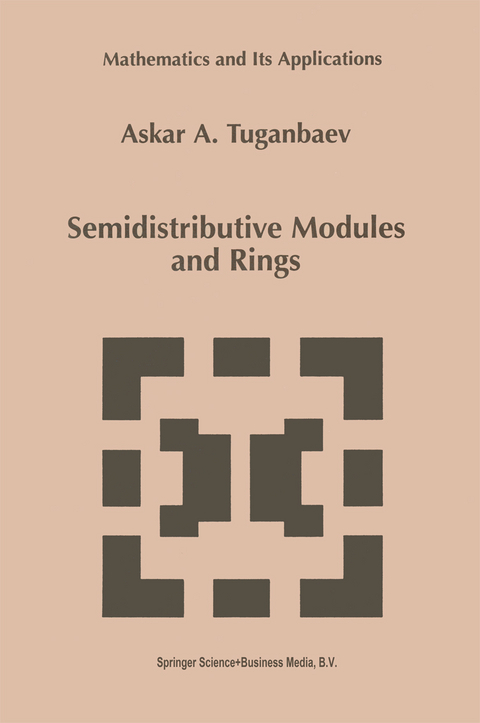
Semidistributive Modules and Rings
Springer (Verlag)
978-94-010-6136-0 (ISBN)
A module M is called distributive if the lattice Lat(M) of all its submodules is distributive, i.e., Fn(G + H) = FnG + FnH for all submodules F,G, and H of the module M. A module M is called uniserial if all its submodules are comparable with respect to inclusion, i.e., the lattice Lat(M) is a chain. Any direct sum of distributive (resp. uniserial) modules is called a semidistributive (resp. serial) module. The class of distributive (resp. semidistributive) modules properly cont.ains the class ofall uniserial (resp. serial) modules. In particular, all simple (resp. semisimple) modules are distributive (resp. semidistributive). All strongly regular rings (for example, all factor rings of direct products of division rings and all commutative regular rings) are distributive; all valuation rings in division rings and all commutative Dedekind rings (e.g., rings of integral algebraic numbers or commutative principal ideal rings) are distributive. A module is called a Bezout module or a locally cyclic module ifevery finitely generated submodule is cyclic. If all maximal right ideals of a ring A are ideals (e.g., if A is commutative), then all Bezout A-modules are distributive.
Askar Tuganbaev received his Ph.D. at the Moscow State University in 1978 and has been a professor at Moscow Power Engineering Institute (Technological University) since 1978. He is the author of three other monographs on ring theory and has written numerous articles on ring theory.
1 Radicals, local and semisimple modules.- 1.1 Maximal submodules and the Jacobson radical.- 1.2 Local and uniserial modules.- 1.3 Semisimple and Artinian modules.- 1.4 The prime radical.- 2 Projective and injective modules.- 2.1 Free and projective modules.- 2.2 Injective modules.- 2.3 Injective hull.- 3 Bezout and regular modules.- 3.1 Regular modules.- 3.2 Unit-regular rings.- 3.3 Semilocal rings and distributivity.- 3.4 Strongly regular rings.- 3.5 Bezout rings.- 4 Continuous and finite-dimensional modules.- 4.1 Closed submodules.- 4.2 Continuous modules.- 4.3 Finile-dimensional modules.- 4.4 Nonsingular ?-injective modules.- 5 Rings of quotients.- 5.1 Ore sets.- 5.2 Denominator sets and localizable rings.- 5.3 Maximal rings of quotients.- 6 Flat modules and semiperfect rings.- 6.1 Characterizations of flat modules.- 6.2 Submodules of flat modules.- 6.3 Semiperfect and perfect rings.- 7 Semihereditary and invariant rings.- 7.1 Coherent and reduced rings.- 7.2 Invariant rings.- 7.3 Rings with integrally closed factor rings.- 8 Endomorphism rings.- 8.1 Modules over endomorphism rings and quasi injective modules.- 8.2 Nilpotent endomorphisms.- 8.3 Strongly indecomposable modules.- 9 Distributive rings with maximum conditions.- 9.1 Arithmetics of ideals.- 9.2 Noel.herian rings.- 9.3 Classical rings of quotients of distributive rings.- 9.4 Rings algebraic over their centre.- 10 Self-injective and skew-injective rings.- 10.1 Quasi-frobenius rings and direct sums of injective modules.- 10.2 Cyclic ?-injective modules.- 10.3 Integrally closed Noetherian rings.- 10.4 Cyclic skew-injective modules.- 10.5 Countably injective rings.- 11 Semidistributive and serial rings.- 11.1 Semidistributive modules.- 11.2 Semidistributive rings.- 11.3 Serial modules and rings.- 12 Monoidrings and related topics.- 12.1 Series and polynomial rings.- 12.2 Quaternion algebras.- 12.3 Subgroups, submonoids, and annihilators.- 12.4 Regular group rings.- 12.5 Cancellative monoids.- 12.6 Semilattices and regular monoids.
| Reihe/Serie | Mathematics and Its Applications ; 449 | Mathematics and Its Applications ; 449 |
|---|---|
| Zusatzinfo | X, 357 p. |
| Verlagsort | Dordrecht |
| Sprache | englisch |
| Maße | 160 x 240 mm |
| Themenwelt | Mathematik / Informatik ► Mathematik ► Algebra |
| ISBN-10 | 94-010-6136-X / 940106136X |
| ISBN-13 | 978-94-010-6136-0 / 9789401061360 |
| Zustand | Neuware |
| Informationen gemäß Produktsicherheitsverordnung (GPSR) | |
| Haben Sie eine Frage zum Produkt? |
aus dem Bereich


